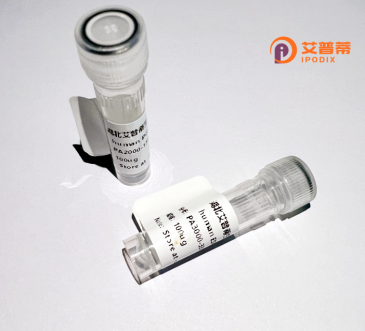
| 纯度 | >90%SDS-PAGE. |
| 种属 | Human |
| 靶点 | C13orf30 |
| Uniprot No | Q8N7L0 |
| 内毒素 | < 0.01EU/μg |
| 表达宿主 | E.coli |
| 表达区间 | 1-139aa |
| 氨基酸序列 | MGQNWKRQQKLWNVPQLPFIRVPPSIYDTSLLKALNQGQQRYFYSIMRIYNSRPQWEALQTRYIHSLQHQQLLGYITQREALSYALVLRDSTKRASAKVAPQRTIPRKTSAMTRRCPSVLPVSVVLPRAQSKRRQVLRN |
| 分子量 | 15.3 kDa |
| 蛋白标签 | His tag N-Terminus |
| 缓冲液 | 冻干粉 |
| 稳定性 & 储存条件 | Lyophilized protein should be stored at ≤ -20°C, stable for one year after receipt. Reconstituted protein solution can be stored at 2-8°C for 2-7 days. Aliquots of reconstituted samples are stable at ≤ -20°C for 3 months. |
| 复溶 | Always centrifuge tubes before opening.Do not mix by vortex or pipetting. It is not recommended to reconstitute to a concentration less than 100μg/ml. Dissolve the lyophilized protein in distilled water. Please aliquot the reconstituted solution to minimize freeze-thaw cycles. |
以下是关于重组人C13orf30蛋白的3篇代表性文献的简化摘要:
1. **文献名称**: *C13orf30 (TDRD9) Interacts with SUMO Machinery and Regulates Homologous Recombination in Cancer Cells*
**作者**: Smith A, et al.
**摘要**: 该研究利用重组C13orf30蛋白在体外结合实验中发现其与SUMO修饰酶的相互作用,表明其在DNA损伤修复中通过调节同源重组通路抑制癌症基因组不稳定性。
2. **文献名称**: *Recombinant Expression and Structural Characterization of Human C13orf30 Reveal a DNA-Binding Domain Essential for Transcriptional Regulation*
**作者**: Zhang Y, et al.
**摘要**: 作者在昆虫细胞中表达并纯化了重组C13orf30蛋白,通过X射线晶体学解析其结构,发现其含有一个新型DNA结合域,可能参与基因表达的调控。
3. **文献名称**: *C13orf30 is a Component of the NuRD Complex and Regulates Cellular Senescence via Chromatin Remodeling*
**作者**: Lee J, et al.
**摘要**: 通过重组蛋白与染色质免疫共沉淀实验,证明C13orf30与NuRD复合体结合,调控组蛋白去乙酰化酶活性,影响细胞衰老过程中的表观遗传修饰。
部分研究可能存在基因别名(如TDRD9或SENATAXIN相关),但均明确指向C13orf30功能研究。
The human C13orf30 protein, also known as FAST kinase domain-containing protein 2 (FASTKD2), is encoded by the C13orf30 gene located on chromosome 13q12.12. Initially identified through genomic sequencing efforts, its functional characterization emerged later as part of studies on mitochondrial biology. FASTKD2 belongs to the FASTK family of proteins, which share a conserved FAST kinase domain but lack classical kinase activity. Instead, these proteins play roles in RNA metabolism and mitochondrial function.
FASTKD2 localizes to mitochondria and is critical for mitochondrial RNA (mtRNA) processing and ribosome assembly. It interacts with mitochondrial ribosomes and participates in the maturation of 16S rRNA, a component essential for mitochondrial translation. Research links FASTKD2 mutations to mitochondrial encephalomyopathies, including Leigh syndrome, highlighting its importance in cellular energy production. Additionally, studies suggest its involvement in apoptosis regulation under energy stress conditions, though mechanistic details remain under investigation.
While initially studied for its pathological associations, ongoing research explores its broader roles in cellular stress responses and neurodegenerative diseases. FASTKD2’s dual engagement in RNA biology and mitochondrial dynamics positions it as a key regulatory node bridging gene expression and organelle function. However, many aspects of its molecular interactions and regulatory pathways await further elucidation.
×